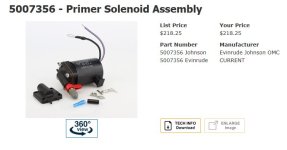I've tried every which way to cold start my friend's 1990 70hp Evinrude without over reving it, but it seems almost impossible. It has a priming pump which is controlled at key switch. I don't not like to rev my own 1990's Johnson/Evinrude engines at more than 2000 when I start them, but this one is impossible, on it's own it'll shoot up to who know what, 6000++, when the throttle is in a spot where it'll be 1800 rpm. Isn't harmful to start that way? Could it be puddling of fuel because of clogged fuel recirculation valves? Or is it just that some engines are like that?
I have not used the engine but in a tank so far, so I'm only talking about the initial cold starts
I have not used the engine but in a tank so far, so I'm only talking about the initial cold starts


